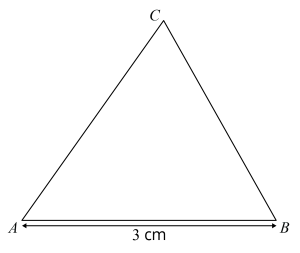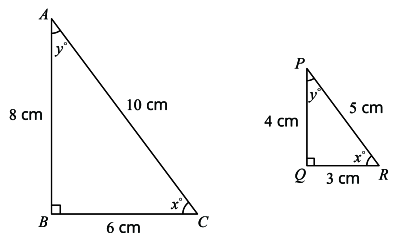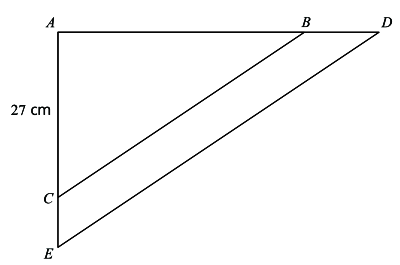Congruence And Similarity
In this chapter, we will be discussing the below-mentioned topics in detail:
- Scale Factor
Enlargement and Reduction of Plane Figures - Map and Scales
Length Scale
Congruence and Similarity
| CONGRUENCE | SIMILARITY | |
|---|---|---|
| Shape | Same | Same |
| Size | Same | May Be Different |
Scale Factor
Scale Factor comes into the picture when we either reduce i.e. make an image smaller or enlarge the original image i.e. make it bigger.
\(\small{\bbox[20px, #27aae1, border: 5px solid #262262] { \displaystyle{\text{ }\\[2ex] \color{white}{\text{Scale Factor} = \frac{\text{Length Of Side In Resultant Image}}{\text{Length Of The Corresponding Side In Original Image}}}\\[4ex] } } }\)
Let’s understand this with the help of some examples:
Question 1:
\(\mathrm{\triangle PQR}\) is formed by scaling \(\mathrm{\triangle ABC}\). What is the scale factor?

Original

Resultant
Solution:
\(\mathrm{\triangle ABC}\) is the original triangle and \(\mathrm{\triangle PQR}\) is the resultant triangle.
\(\small{\begin{align*} \text{Scale factor} &= \frac{\text{Length Of Side In Resultant Image}}{\text{Length Of Corresponding Side In Original Image}} \\ \\ \mathrm{\frac{PQ}{AB}} &= \mathrm{\frac{5\;cm}{3\;cm}} \\ \\ &= 1\frac{2}{3} \end{align*}}\)
Question 2:
\(\mathrm{\triangle ABC}\) is similar to \(\mathrm{\triangle PQR}\). \(\mathrm{\triangle PQR}\) is formed by scaling \(\mathrm{\triangle ABC}\). What is the scale factor?
What can we say about the relationship between the scale factor and the resultant image?

Solution:
\(\mathrm{\triangle ABC}\) is the original triangle and \(\mathrm{\triangle PQR}\) is the resultant triangle.
\(\small{\begin{align*} \text{Sacle Factor} &= \frac{\text{Length Of Side In Resultant Image}}{\text{Length Of Corresponding Side In Original Image}} \\[2ex] \frac{\mathrm{PQ}}{\mathrm{AB}} &= \frac{\mathrm{4\;cm}}{\mathrm{8\;cm}}\\[2ex] &= \frac12 \end{align*}}\)
Hence, the scale factor is less than \(1\) and the resultant image is smaller than the original.
Question 3:
\(\mathrm{\triangle ABC}\) is similar to \(\mathrm{\triangle PQR}\). \(\mathrm{\triangle PQR}\) is formed by scaling \(\mathrm{\triangle ABC}\). What is the scale factor?
What can we say about the relationship between the scale factor and the resultant image?

Solution:
\(\mathrm{\triangle ABC}\) is the original triangle and \(\mathrm{\triangle PQR}\) is the resultant triangle.
\(\small{\begin{align*} \text{Sacle Factor} &= \frac{\text{Length Of Side In Resultant Image}}{\text{Length Of Corresponding Side In Original Image}} \\[2ex] \frac{\mathrm{PQ}}{\mathrm{AB}} &= \frac{\mathrm{4\;cm}}{\mathrm{4\;cm}}\\[2ex] &= 1 \end{align*}}\)
Hence, the scale factor is equal to \(1\) and the resultant image is of the same size as the original.
Scale Factor
In general, a figure and its resultant image are similar.
| Scale Factor | Resultant Image |
|---|---|
| \(k > 1\) | It would be enlarged i.e. resultant image would be bigger than the original. |
| \(0 < k < 1\) | Reduced/ Smaller than the original |
| \(k = 1\) | It would be unchanged i.e. congruent |
Alternate form of Scale Factor Formula
\(\small{\bbox[20px, #27aae1, border: 5px solid #262262] { \displaystyle{\text{ }\\[2ex] \color{white}{\text{Scale Factor} = \frac{\text{Length Of Side In Resultant Image}}{\text{Length Of The Corresponding Side In Original Image}}}\\[4ex] } } }\)
\(\small{\bbox[20px, #27aae1, border: 5px solid #262262] { \displaystyle{ \text{ }\\[2ex] \color{white}{ \text{Length Of Side In Resultant Image} =\text{Scale Factor} \times \text{Original Length} }\\[4ex] } } }\)
Question 4:
\(\mathrm{\triangle ADE}\) is an enlargement of \(\mathrm{\triangle ABC}\) with a scale factor of \(\displaystyle{1\frac {4}{9}}\). Given that \(\text{AC = 27 cm}\), find the length of \(\text{CE}\).

Solution:
Method 1:
\(\mathrm{\triangle ADE}\) and \(\mathrm{\triangle ABC}\) are similar because it is just an enlargement.
\(\small{\begin{align*} \text{Scale Factor} &= \frac{\text{Length Of Side In Resultant Image}}{\text{Length Of Corresponding Side In Original Image}} \\[2ex] \mathrm{ \frac{AE}{AC}} &= 1\frac{4}{9}\\[2ex] \mathrm{\frac{AC+CE}{AC}} &= \frac{13}{9}\\[2ex] \mathrm{\frac{27+CE}{27}} &= \frac{13}9\\[2ex] \mathrm{CE} &= 27 \bigg(\frac{13}9\bigg) - 27\\ \\ &= \text{12 cm} \end{align*}}\)
Method 2:
\(\small{\begin{align*} \text{Resultant Length} &= \text{Scale Factor × Original Length} \\[2ex] \text{AE} &= 1\frac{4}{9} \times \text{AC}\\[2ex] &= 1\frac{4}{9} × 27\\[2ex] &= \text{39 cm}\\ \\ \text{CE} &= \text{AE – AC}\\ \\ &= 39 - 27\\ \\ &= 12 \text{ cm} \end{align*}}\)
Concept of Ratio
A ratio compares two quantities of the same kind that either has no units or are measured in the same units.
The ratio \(\displaystyle{a : b}\), where \(a\) and \(b\) are positive integers, has no units.
Length Scale
For example, a map has a scale where \(1 \text{ cm}\) represents \(1 \text{ km}\). Express the map scale as a ratio in the form \(\displaystyle{1: n}\), where \(n\) is an integer.
\(\small{\begin{align*} 1\text{ cm} &: 1\text{ km}\\[2ex] 1\text{ cm} &: 1000 \text{ m}\\[2ex] 1\text{ cm} &: 100000 \text{ cm}\\[2ex] 1 &: 100000 \end{align*}}\)
Let’s understand this with the help of some examples:
Question 5:
A map has a scale of \(1 \text{ cm}\) to \(4 \text{ km}\). Find
- the actual distance, in \(\text{km}\), is represented by \(6.8 \text{ cm}\) on the map.
- the length on the map represents an actual distance of \(15.8 \text{ km}\).
- the scale of the map in the form \(\displaystyle{\frac{1}{n}}\), where \(n\) is an integer.
Solution:
- Map : Actual
\(\small{1 \text{ cm} : 4 \text{ km}}\)
Multiplying both sides of the ratio by \(\small{6.8}\),
\(\small{\begin{align*} (1 × 6.8) \text{ cm} &: (4 × 6.8) \text{ km}\\[2ex] 6.8 \text{ cm} &: 27.2 \text{ km} \end{align*}}\)
Hence, the actual distance is \(\small{27.2 \text{ km}}\).
- Map : Actual
\(\small{1 \text{ cm} : 4 \text{ km}}\)
Dividing both sides of the ratio by \(\small{4}\),
\(\small{0.25 \text{ cm} : 1 \text{ km}}\)
Multiplying by \(\small{15.8}\),
\(\small{3.95 \text{ cm} : 15.8 \text{ km}}\)
Hence, the length on the map is \(\small{3.95 \text{ cm}}\).
\(\small{\begin{align*} 1 \text{ cm} &: 4 \text{ km}\\[2ex] 1 \text{ cm} &: 4000 \text{ m}\\[2ex] 1 \text{ cm} &: 400000 \text{ cm} \end{align*}}\)
The scale of the map is \(\small{\displaystyle{\frac{1}{400000}}}\).
| Continue Learning | |
|---|---|
| Algebraic Fractions | Direct & Inverse Proportion |
| Congruence And Similarity | Factorising Quadratic Expressions |
| Further Expansion And Factorisation | Quadratic Equations And Graphs |
| Simultaneous Equation | |


 SG
SG  VN
VN 















